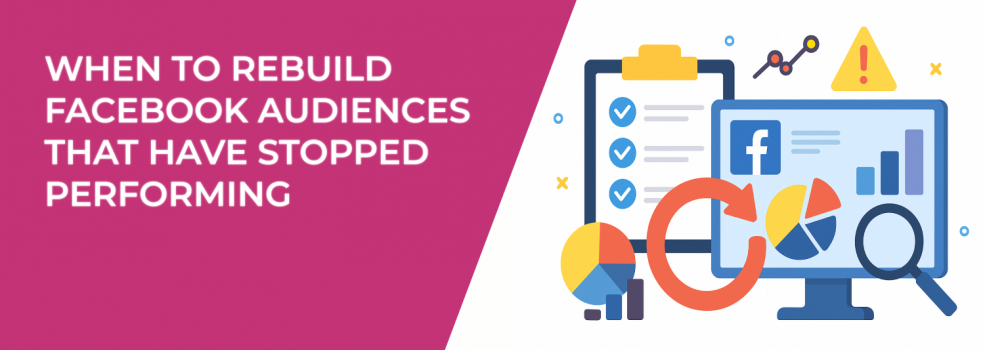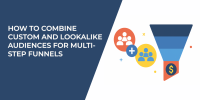Facebook advertising success relies heavily on targeting the right people at the right time. But here’s the thing: even the most well-crafted audiences lose effectiveness over time.
People's behavior shifts. Interests fade. Purchase cycles end. If you’re still targeting the same pool of users months later without results, you’re probably wasting money — and missing opportunities to reach the customers who are actually ready to act.
But when should you actually rebuild your audiences? And how do you avoid doing it too early (or too late)? Let’s explore that in depth.
Telltale Signs Your Facebook Audience Has Gone Cold
You don’t need a sixth sense to spot an underperforming audience — the data usually makes it obvious. But the signs aren't always loud, and many advertisers ignore them until results are already tanking. Here are the most common indicators your audience has run its course:
-
Click-Through Rate (CTR) is steadily dropping
If fewer people are clicking your ads, it's a clear signal that your messaging is either irrelevant or being shown to the wrong crowd. Over time, this can severely impact your ad quality score and cost-efficiency. -
CPM or CPC is rising while conversions decline
Paying more for impressions or clicks while getting fewer results? This often means Facebook's algorithm is struggling to find interested users within your selected audience. -
Return on Ad Spend (ROAS) keeps shrinking
Even if you're still getting clicks, if the people you're targeting aren't buying, your ROAS will slide. It’s one of the clearest red flags that your targeting needs a serious refresh. -
Frequency is high, but people aren’t converting
If your ads are being shown to the same people repeatedly without conversions, they’ve likely grown blind to your content. This is audience fatigue in action — and it can quietly kill performance. If you're not sure how to recognize it, check out our guide on how to spot ad fatigue early and fix it fast. -
Engagement has dried up completely
No comments, shares, or reactions? That signals a lack of relevance or novelty — two things your targeting should always aim to deliver.
If you're seeing several of these signs at once, it's not just a bad week — it's a pattern. And patterns like these deserve action, not guesswork.
Is It Really the Audience — or Something Else?
Before scrapping everything and starting over, it’s worth pausing and asking a few important questions.
Are you still offering the same thing you did when the audience was working well? Have you changed your visuals or copy recently? Could market conditions or seasonality be playing a role in performance dips?
Sometimes the problem isn’t the audience at all. A great audience can underperform if paired with tired creatives, irrelevant offers, or ineffective bidding strategies.
Before rebuilding, test these first:
-
Refresh your creatives (images, videos, headlines).
-
Reevaluate your offer — is it still compelling to this audience?
-
Check for ad fatigue or delivery issues in Ads Manager.
-
Adjust your placements and delivery settings.
If you’ve done all of the above and performance is still slipping? That’s your cue to rebuild.
5 Situations When Rebuilding Your Facebook Audience Makes Sense
Not every dip in results means it’s time to panic. But there are several specific scenarios when a full rebuild is not only justified — it's necessary.
Here are five of the most common:
-
Ad fatigue is happening across multiple creatives
When multiple new ad versions underperform with the same audience, it’s a sign the problem isn’t the ad — it’s the people seeing it. At this point, rebuilding the audience is more effective than endlessly testing creatives. -
Your ad frequency is high, but nothing’s converting
Frequency above 3 (and especially above 5) with declining results often means overexposure. These people have already made up their minds — or they're just not interested. Time to find new ones. -
Your lookalike audience isn’t delivering anymore
If you created lookalikes based on email lists from two years ago or outdated pixel data, they’ve likely lost relevance. Lookalikes decay faster than most think — the algorithm needs fresh signals to stay accurate. To dig deeper into audience types and how they stack up, read our breakdown of custom vs lookalike audiences. -
Your business has pivoted significantly
If you've changed your product line, brand identity, pricing model, or value proposition, your old audience might no longer match your ideal customer. In that case, a clean slate is often the best path forward. -
You've tested everything else for weeks — and nothing's working
If your ad account has seen 3+ weeks of testing across different creatives, placements, objectives, and formats, and results still haven’t improved, then the audience itself is very likely the root cause. Not sure whether it’s just a bad ad set or a deeper issue? This article can help you troubleshoot failing ad sets.
In these situations, rebuilding isn’t about giving up — it’s about realigning your targeting with the current behavior of your customers and prospects.
How to Rebuild Your Facebook Audience Without Losing Momentum
A fresh start doesn’t mean throwing everything away. The best audience rebuilds are based on insight — not panic.
Here’s how to rebuild smartly:
1. Audit and Clean Up Your Custom Audiences
Start by identifying which custom audiences are underperforming and why. Many advertisers keep using old customer lists or website visitors from irrelevant timeframes.
Update your source data:
-
Use only recent purchases or high-intent site actions.
-
Segment audiences by behavior (buyers vs browsers, cart abandoners vs subscribers).
-
Set time windows that reflect current engagement, like 30–60 days max.
Old data = irrelevant targeting. Trim the fat.
2. Rebuild Lookalike Audiences With High-Quality Seeds
Your lookalikes are only as good as the sources they’re built on. Don’t use generic email lists or visitors from random blog posts.
Instead, create lookalikes from:
-
Customers with high average order value.
-
Repeat buyers.
-
Newsletter subscribers with high open/click rates.
-
People who completed high-value events (like scheduling a call or signing up for a trial).
Also, experiment with different sizes:
1% for precision, 2–5% for scale. Don’t just pick one and hope for the best.
3. Rethink Your Interest-Based Targeting
Interest targeting isn't dead — it’s just misunderstood. If you’ve been stacking too many interests or relying on broad categories, it’s time to simplify.
Layer relevant interests based on actual buyer intent and behavior.
For example: instead of targeting “Marketing” as a broad interest, try layering “Digital Advertising” + “Facebook Business Page Admins” + “Online Marketing Tools.”
Keep the structure focused and logical — don’t go too wide or too narrow. And always split-test your interest groups to compare performance.
4. Don’t Ignore Broad Targeting — Just Use It Strategically
When your pixel has been trained with enough data, Facebook’s algorithm can do a decent job with broader targeting. But it’s not for beginners or low-data accounts.
Use broad audiences only if:
-
Your pixel is tracking thousands of quality events per month.
-
Your creative speaks directly to your ideal customer.
-
You’re optimizing for conversions or value-based events (not reach or traffic).
When done right, broad targeting allows scale. But when done blindly, it wastes budget fast.
Takeaway: Audience Quality Drives Everything
Your Facebook ad performance doesn’t live in your ad copy or budget — it lives in your targeting. When your audience loses alignment with your business goals or user behavior, everything else suffers.
Watch for the signs. Take the time to test. And don’t be afraid to rebuild if the data tells you it’s time.
Because in the fast-moving world of Meta ads, what worked yesterday might already be outdated today.

